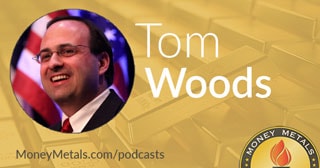10:29 AM Central Bankers Bash Cryptos as Unbacked, “Ponzi Schemes” | |
Mike Gleason: It is my great privilege to be joined by Tom Woods, senior fellow at the Mises Institute, and host of the Tom Woods Show. Tom is a well-known Liberty minded scholar with a Bachelor's in History from Harvard and a Doctorate from Columbia University. He's authored many books including Nullification, Meltdown, The Politically Incorrect Guide to American History, Who Killed the Constitution, and many others which you can learn all about at TomWoods.com. Tom, first off I want to thank you for spending some time with us and I'm excited to have you on today. Welcome. Tom Woods: You too Mike. Thank you very much. Mike Gleason: Your background in both U.S. and world History along with your understanding of free market economic theory is the primary reason we asked you to come on today because history is such an important guide for us. Now first, I want to have to take us back to the formation of our country and give us a brief summary if you would about why our Founding Fathers devised and constructed things the way they did, primarily as it relates to our money and our monetary system and the role that gold and silver were to play. So first off before we get into how much we've gotten off track from what the founders had in mind, talk about why they came up with a bimetallic system that used gold and silver. Tom Woods: It was very common in colonial times for people to use... it was actually a Spanish coin that was the most frequently used coin. It was called the Spanish Milled Dollar and it was a silver coin. This was in wide circulation. It's true that there were episodes in which paper money was used in the colonies. We see that first in Massachusetts in 1690. And Benjamin Franklin was actually agitating for paper money in Pennsylvania. It turned out that guess whose print shop was going to get the contract to print the money. Might not have been entirely an economic argument that old Ben was making in that case. By and large there was, with the exception of the Revolutionary War, there was an emphasis on hard money. Of course during the Revolutionary War, we all know the standard story, which is that the continental currency was continually debased. It was a paper kind of money and it would be debased. We even had a story of somebody wanting to pay back a debt and the money was so worthless that the creditor was actually running away. The person was threatening to repay him. He didn't want to be repaid in that type of worthless currency. So a lot of people drew conclusions from this that it's much, much better to have a sound currency, a sound money, that can't be so easily manipulated by government. That is the reason that precious metals, gold and silver in particular, have been the money in so many parts of the world. They were money for a thousand years at least in the Byzantine Empire, that's why. In fact Ludwig von Mises, the great economist, said that sound money belongs right up there with bills of rights and written constitutions in terms of guarantees of the rights of the people. Sound money. It's disparaged today, it's made fun of today, people say it's backward and stupid and we're much more sophisticated now, but there's nothing to that whatsoever. Mike Gleason: Now the hard money advocates did face some dissension however, talk about what followed and some of the other key moments in our monetary history during say the first 100 years of our nation. Read/Listen to the full podcast (here)
| |
|
| |
| Total comments: 0 | |
